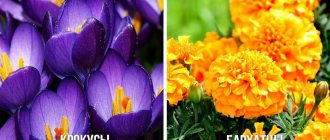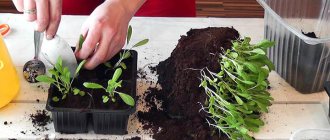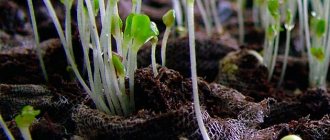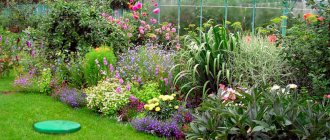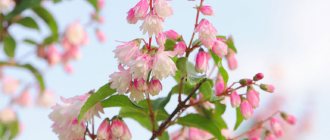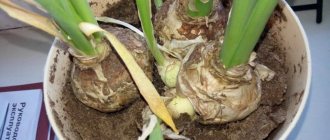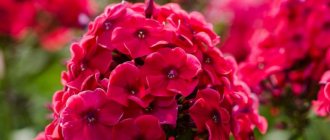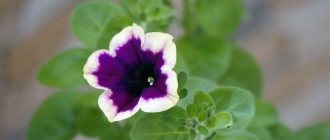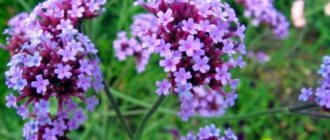Delicate nemophila flowers
Nemophila is a newcomer among the annuals we grow. She comes from North America, where she prefers to grow on forest edges. In Russia, it is often called the American forget-me-not for its external resemblance to this flower. And at home - blue-eyed for its bright blue color.
Forget-me-nots
Plant characteristics
Nemophila is native to the North American continent. It is most often found wild in Canada, Mexico and the southeastern United States. The British call it blue-eyed, and the Russians call it American forget-me-not. This is a beautiful plant with a surprisingly delicate bud, but it only blooms for 1 year. Therefore, it requires annual sowing. Its stem grows up to 25 cm, and meanders along the ground. Buds with symmetrical, bowl-shaped petals grow from the axils of the leaves.
The flowers are small - only 3 cm in diameter; you can find a variety of petal colors from sky blue to ultramarine blue with white and beige splashes. In the wild there are species of white and pale yellow shades.
Nemophila is grown from seeds. Planting material purchased once remains fresh for a long time; it is suitable for planting even after 2 years. There are up to 400 seeds in one gram. Choosing this plant is a good solution for decorating a flower bed in the garden. This is one of the longest blooming flowers. The first buds bloom in early summer, and the last ones fade only by mid-autumn. If you let the capsules ripen, you can collect a lot of seeds. In some varieties they are smooth, in others they are wrinkled. In order for planting material to retain good germination, it must be stored in a dry place at a temperature of 10 to 25 degrees.
Description of Nemophila
Being native to North America, this plant has taken root and is loved in many countries. Japan's Hitachi Park even hosts a real festival when the blue nemophila blooms, turning the ground the color of the sky. In the vast expanses of the former USSR, it also found use: a herbaceous plant from the Aquifolia family is grown near reservoirs, along garden paths, and used to decorate alpine hills.
Nemos means grove and phileo means to love. It is believed that the plant was named so because it feels best in shady groves, and does not like open areas fully illuminated by the sun. Nemophila needs to be planted every year, because it belongs to the type of annual, but at the same time – long-flowering. By the way, its flowers are not only blue: there are also white with dark spots and purple with a nice light border.
Characteristics of nemophila
This trailing plant does a wonderful job of filling empty spaces in the garden and between tall bushes and flowers. What else you need to know about nemophila:
- The height of the nemophila plant is up to 20 cm, it has spreading thin stems, lying in light curls on the ground.
- Its leaves are feathery, covered with barely noticeable fluff, and single buds form in their axils.
- The opened flower resembles a bell, up to 4 cm in diameter, and its color depends on the type of plant.
- After flowering, nemophila leaves fruits in the form of a spherical box with several seeds inside, suitable for sowing in the future.
Conditions for American forget-me-not
Growing nemophila is not a labor-intensive process. The flower does not require special conditions for growth. Plants do well in the shade, but some gardeners notice that in bright sunlight the shade of the buds is richer and deeper.
The condition and acidity of the soil for flowers also does not play an important role. The only thing that needs to be observed is a constant level of moisture. Throughout the life of the plant, the roots must have access to water. Even short-term dry periods negatively affect its appearance. If the air temperature is too high, the soil overheats and dries out, then the nemophila stops blooming altogether and drops its buds.
The soil on the site should contain useful substances, but this is not the most important factor. The main thing is to keep the soil loose so that moisture penetrates to the roots. Under natural conditions, nemophila grows near rivers or lakes. There is a sufficient level of moisture there for them. Therefore, for lush flowering in the flowerbed, conditions should be created as close as possible to the usual living conditions.
Watering
Nemophila flower photos
Flowering time is a period of particular sensitivity to lack of moisture. Therefore, excessive dryness of the soil forces the plant to take protective measures: leaves begin to fall to the ground, flower buds stop growing and may droop. If the weather is dry, it is necessary to water two or three times a week; you can mulch the soil by spreading fine humus or peat to reduce the evaporation of moisture from the ground. It is important to loosen the soil between the bushes.
Varieties of varieties
In California, nemophilas have been cultivated since 1848; they gradually spread throughout the continent, and then migrated to other countries. The plant gained the greatest popularity in Japan. Every year a festival is held in this country where gardeners show new varieties of flowers.
| Name | Description | Varieties |
| Nemophila spotted | The buds are symmetrical. The main shade is white; the petals have spots ranging from azure blue to violet. Grows in height up to 25 cm. Single flowers on long stalks up to 2 cm, cupped up to 5 cm in diameter. The leaves are opposite oblong or oval. | Barbara - the petals are distinguished by the fact that the outer side is painted purple. Gardeners often plant flowers in pots or baskets, which they then hang to decorate balconies and terraces. |
| Ladybug - there is a blue or blue circle on the edges of the petals. The buds are larger, growing up to 5 cm. | ||
| Menzis | The buds can be the same color or have a white core. It grows quickly and takes up all the space available in the flowerbed. The plant forms a beautiful carpet of blue-violet buds. The buds are small - up to 2 cm in diameter. Used as an hanging plant, to decorate border areas and rocky gardens, and used for summer field bouquets. | Coelestis - petals of a light beige tone with blue edges. |
| Penny Black - dark purple petals, almost black, with white stripes on the edges of the petals. | ||
| Oculata - blue-white buds with bright spots in the middle. |
Use in landscape design
Due to its small stature, nemophila is exclusively a foreground plant in various compositions. But it can also “perform” solo, both in flower beds and ridges, and as a container culture.
Finding a suitable place for it will not be difficult, since it has few competitors among light-loving annuals. Nemophila also loves light, but diffused, and grows well in partial shade - under trees and larger ornamental plants.
Nemophila in a flower arrangement
In landscape design, miniature American forget-me-nots are used as flowering lawns, undergrowth for large plants, borders for flower beds and paths. And also as a soil filler between short-flowering bulbous crops.
It can decorate an alpine hill, the bank of an artificial pond or stream, a balcony or terrace.
Nemophila near a pond
In composition with other annuals
Border of white nemophila
A field of blue flowers is associated with the sea
Flowerbed with nemophilas from an old wheelbarrow
Openwork leaves and delicate simple flowers of nemophila perfectly complement many garden crops. This low-growing, creeping plant can provide a backdrop for large, tall perennials such as roses or clematis.
And in the company of other flyers, it will act as a full-fledged partner, creating an idyllic pastoral picture in country style.
Nemophila among other annuals
How to grow from seeds
Even inexperienced gardeners can grow seedlings on their own. You just need to decide on the timing of planting on the site:
- Timing depends on geographic location. For central Russia, the optimal sowing time is the first days of April. By mid-May, strong seedlings will have grown and can be planted in the garden. In the southern parts of the country, grown flowers are transplanted into open ground already in April, so the seeds are sown in early March.
- How to sow seedlings. The rules for growing seedlings are the same for all flowering plants. The planting container is filled with slightly moist soil. The seeds are placed at a distance of about 7-8 cm from each other, the depth is no more than 10 mm. Sprinkle a loose substrate or light purchased soil on top. After this, the soil is sprayed again with settled water at room temperature from a spray bottle. Polyethylene is stretched over the container or transparent glass is installed. The boxes are moved to a warm, well-lit place. When sprouts begin to appear, the polyethylene is removed. Nemophilas do not pick, the flowers are too sensitive. When the weather becomes warm outside, you can take out containers with seedlings for several hours so that the sprouts become stronger and more resilient. If the seedlings become very elongated or turn pale, add light to them.
- Planting nemophila in open ground. The normal height for transplanting seedlings is up to 90 mm; when they are higher, the plant does not take root well and may die. To get a beautiful carpet of buds, leave no more than 15 cm between sprouts. Seeds can be sown directly into the ground, but then the annual will bloom much later. In this case, the seeds are deepened no more than 2 cm. Nemophila is also suitable for planting in those areas of the garden where there is not enough light for other plants. This flower feels equally good in low light and in bright light.
Nemophila transplant
Once a flower has been planted from a seedling pot into the ground, it is advisable not to touch it anymore. Nemophila is an unpretentious plant, but very delicate, sensitive to damage to the roots. If there is a need for a transplant, you should make every effort to do it carefully:
- Dig around the perimeter of the plant, leaving about 50 cm on each side of it.
- Deepen the dig so as not to touch the roots with a shovel.
- Remember that not a single thin root should be damaged in the process, otherwise the whole plant will wither.
- Carefully transfer the nemophila along with the soil to a new location.
- Compact the soil and water the flower thoroughly.
Flower care
Nemophila care includes several features:
- Watering. Caring for a blue-eyed plant is a troublesome task; watering the plant is the main feature to which you will have to devote the most time and effort. Nemophila is long-flowering, but the buds will quickly wither if the required level of moisture in the soil is not maintained. The flower is watered regularly to keep the soil slightly moist at all times. Soft water at the same temperature as the soil is suitable for the plant. When watering, it is advisable to loosen the soil a little so that the liquid flows freely to the roots.
- Trimming. Nemophila does not need pruning. Withered buds detach from the stem on their own. Gardeners do only formative pruning to give the site a neat appearance. Thanks to this pruning, new branches are formed, the flower grows and pleases with abundant flowering. The blue-eye does not tolerate winter cold and dies. What remains in its place after the snow melts is removed in the spring. But if the unsightly appearance of the flowerbed or the appearance of a dead plant bothers flower growers, then after flowering has ended, the plants can be uprooted. They won't bloom again anyway.
- Feeding. If the site has fertile, nutritious soil, fertilizers for nemophila are not applied. But on land devoid of useful elements, fertilizing is carried out twice during the growing season of the plant’s life. For blue-eye, gardeners buy complex mineral fertilizers. They are applied for the first time when the plant’s buds are just forming in May-June. The second time occurs at the peak of flowering - after a month or a month and a half, in June-July. The amount of feeding for nemophilas growing in pots and containers is increased, because in a limited space the soil is emasculated much faster than in large areas. Fertilize the soil weekly from the beginning of summer until flowering ends.
- Protecting the earth from overheating. Overheating of the soil is more dangerous for American forget-me-nots than drying out. Protect plants by mulching. As soon as sprouts appear, the ground on the site is covered with organic matter, small wood shavings or moss. A layer 5 cm thick is formed from them. The protective layer not only prevents overheating, but also retains liquid in the ground.
- Removing weeds. The weeds are weeded out as soon as they appear, so that their roots do not damage the underground part of the blue-eyes. Weeds siphon off nutrients, nemophila grows poorly and few buds are formed. If you remove the weed immediately, before it takes hold, the flower thickens, becomes covered with a dense carpet, and there is no room for the weeds to grow.
Reproduction of nemophila
Alas, a plant planted in the spring will please the eye only until the first frost, and will completely die during the winter. Perennial nemophila is not found in wildlife, so next year the entire sowing process will have to be repeated again. To do this, you don’t need to wait for the “babies” of the flower to appear or dig up the tubers. Nemophila reproduces using seeds. The grains do not retain their reproductive ability for long, so it is advisable not to store them on mezzanines for years, but to plant them the next year.
Diseases and pests
Blue-eye is a fairly new plant for Russia, so it has not yet acquired natural enemies. Only slugs and snails can harm young shoots. They eat small stems, completely destroying them. To repel slugs, plants are sprayed with a tincture of tree ash. This is a folk method of control, but it perfectly protects flowers from pests.
Diseases of the American forget-me-not are associated only with improper care or if it is absent altogether.
If you water the plants in too large quantities, the root system of the flower begins to rot. Drying out the soil also has a negative effect on nemophila. Therefore, to avoid diseases, you need to maintain the correct water balance in the area.
Etymology
The plant's scientific name, Nemophila, comes from the merger of the Latin word "nemus" (meaning "forest") and the ancient Greek word "phileo" (meaning "to love"), which is quite applicable to the habitat of most species of nemophila. The common names of most species of this genus contain the words “blue eyes.” The reason is the predominance of sky blue flowers in color, as bright and pure as the eyes of a newborn child. This color is rare in the plant world, which is why it surprises, delights and pleases the eye.
- The species Nemophila menziesii is commonly known as baby blue-eyes.
- The species Nemophila parviflora was named “Smallflower Baby Blue Eyes”.
- The species Nemophila spatulata is known as "Sierra Baby Blue Eyes" (Sierra is a mountainous region in the United States).
- Nemophila pulchella is also known by the common name Eastwood's Baby Blue Eyes (Louisiana, USA).
In our area, nemophila is more often called “American forget-me-not.”
Combinations with other colors
How to combine nemophila with other flowers
The best option for a nemophila company would be low-growing flowers. Against the background of large flowers, such as asters, low-growing and delicate nemophilas will be lost, and on the contrary, in combination with low-growing plants, an unusual color will stand out favorably.
American Forget-me-not looks especially good with flowers such as:
- Chinese cloves;
- ursinicia;
- gatsaniya;
- Iberis;
- forget-me-nots;
- bells.
Nemophila is excellent as a separate ground cover. The planting itself is quite attractive, inspiring photographers and even artists to capture the splendor of the flowers in photographs and paintings.
Growing
Pneumophila are very easy to grow, mainly because they grow well and bloom profusely in both full sun and partial shade. There are only a few soil and irrigation requirements.
Fertilizer
If manure or compost is applied, no fertilizer is required. But if there is complex fertilizer left in the watering can, after watering other flowers or tomatoes, you can apply it under the nemophila. This way you can extend the period of mass flowering.
Trimming
Flowering can be repeated by cutting the plants in half at the end of flowering. Removing faded flowers greatly speeds up the creation of new ones.
Watering
This plant likes cool and moist soil, so in hot summers, in order for flowering to continue (and this will happen when the temperature rises, especially in the roots), the soil should remain slightly moist. Water not only satisfies the needs of the plant, but also cools the substrate.
Diseases and pests
The plant can be attacked by aphids, red spiders, and whiteflies. Proper care will help avoid physiological diseases. If rot occurs, the plantings should be treated with a fungicide, such as Topaz.
Top dressing
For the rapid development of Nemophila, in addition to watering, you can add additional fertilizing; it is enough to purchase a complex fertilizer. The amount of application of the drug can be read on the packaging. Greens can be fed with this fertilizer once or twice a season. The first time before the buds begin to bud, the second time during active flowering.
On a note!
If you fertilize before the buds set, the plant will reward you with active and lush flowering.
Another important aspect that needs to be paid attention to when growing is the timely removal of weeds, which not only worsen the appearance of the plantings, but also draw moisture from the ground, depleting it, drawing out nutrients. It is better to pull out the weed at the very beginning of its appearance, so that it does not have time to produce root shoots and offspring.
